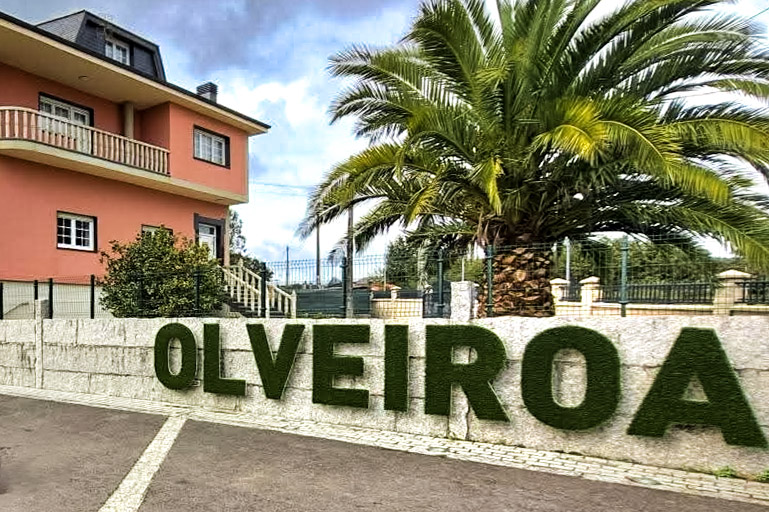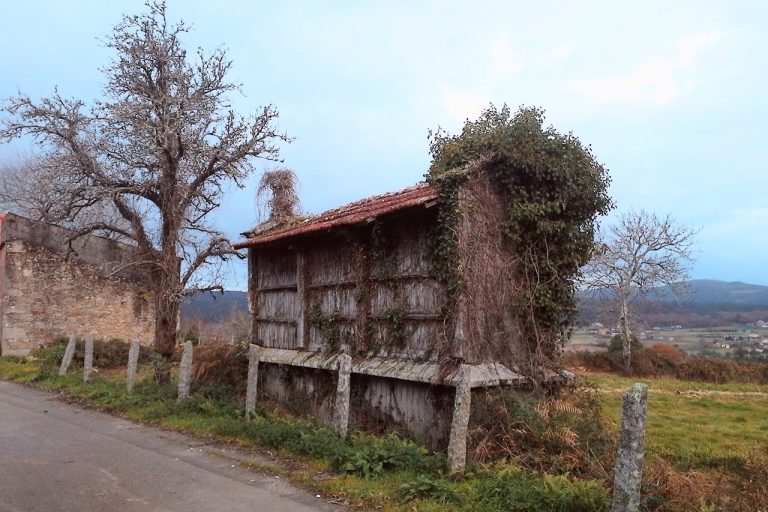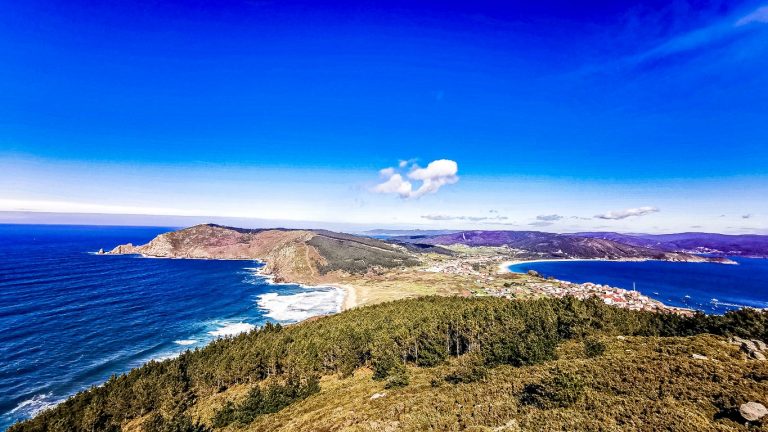
A New Stage Day – Beginning & Mood
Morning in Negreira is cool and quiet. Mist lingers over the fields, and the damp air smells of wood and earth. On the Plaza de España, the first bars open; pilgrims sit in hushed anticipation over coffee and toast. Once you set off, the town fades quickly behind you – only the soft echo of footsteps on wet stone remains.
The stage to Olveiroa is long. It leads deep into the Galician countryside, far from any town, into forests, hamlets, and valleys. It is the day when the Camino Fisterra–Muxía finds its rhythm: fewer voices, more wind. A path that is not spectacular, but true.
With every kilometer, the world of daily life falls further away. What remains is the path, the breath, the sound of birds, and the distant barking of a dog behind a farmhouse.
Route & Elevation Profile
• Distance: approx. 33.6 km
• Elevation: +710 m / –620 m
• Difficulty: moderate to demanding
• Duration: 8–9 hours walking time
• Character: long rural stage with gentle hills, eucalyptus forests, fields, and small hamlets
The second stage is a day of endurance. It rises gently, follows wooded paths, crosses streams and small villages, and by late afternoon reaches the remote hamlet of Olveiroa. The elevation changes are noticeable but never steep.






Description of the Way – With All Senses
You leave Negreira by the Pazo de Cotón, passing the chapel of San Mauro. The path crosses the Barcala River and slowly climbs through the quarter of A Chancela. The asphalt soon disappears, and you walk along narrow country tracks between ferns and stone walls.
After a few kilometers, you reach A Pena, a quiet village with a fountain and a bar – a good place for the first stop. Beyond it, an open stretch unfolds, where the wind catches in the tall grass.
Past Vilaserío (about 8 km), the landscape widens. The village offers simple albergues and a small bar – a familiar stop for pilgrims who wish to divide this long day. The path continues through a mosaic of fields and woods, passing solitary hórreos and stone wells.
The trail climbs toward Monte Aro, the highest point of the day. The ascent stretches over several kilometers, but at the top, the view is wide and calm – Galicia in all its softness. The wind carries moisture, sometimes rain. It’s not a summit that calls for celebration, only one that invites quiet.
The descent to Santa Mariña (about 19 km) passes through pines and eucalyptus, then across small bridges and hamlets where time hardly moves. Those who pause here feel the balance of this way: demanding, but never overwhelming.
Beyond Maroñas (about 25 km), the landscape opens up again, the light becomes clearer. The path continues through Bon Xesús and Corzón, then descends to the Xallas River. At Ponte Olveira (about 31 km), you cross the calm water – a moment of arrival before the destination itself.
A final, gentle climb leads you into Olveiroa. Old granite houses, wooden doors, laundry in the wind. The streets are narrow, the light golden. In the evening, the air smells of bread and smoke. A place that promises nothing and gives exactly that: Peace.
Towns & Highlights
| Town | Distance from Negreira (km) | Highlight | Tip |
| A Pena | 4.5 | Small village with fountain and bar | Breakfast or water stop |
| Vilaserío | 8.0 | Pilgrim village with several albergues | Good half-stage for early starters |
| Cornado | 12.0 | Quiet, rural, open landscape | Rest in the shade of the trees |
| Santa Mariña | 19.0 | Small church, water source, bar | Pause before Monte Aro |
| Maroñas | 25.0 | Peaceful hamlet | Short stretching break |
| Ponte Olveira | 31.0 | Bridge over the Río Xallas | Last rest before Olveiroa |
| Olveiroa | 33.6 | Village with pilgrim tradition | Stage end, lodging, and meal |
Variants & Small Detours
This stage largely follows the traditional route. Cycling pilgrims can avoid the climb to Monte Aro via a side road. Those wishing to divide the day can find simple albergues in Vilaserío or Santa Mariña to split the stage into two parts.
Packing & Shopping Tips
• Carry enough water: few fountains between Vilaserío and Santa Mariña.
• Bring food for the middle section – long stretches without shops.
• Rain and sun protection: changeable weather around Monte Aro.
• In summer: start early, as there is little shade in the afternoon.
• In Olveiroa: small bar, shop, ATM, and pilgrim kitchens in several albergues.
Food, Lodging & Supplies
Vilaserío, Santa Mariña, and Olveiroa all offer accommodation.
In Olveiroa, you’ll find both municipal and private albergues, some offering communal dinners at long tables. The village is small but alive with the rhythm of those arriving.
In the evening, pilgrims meet by the fountain or on the church steps. Conversations fade into the wind until only the hum of crickets remains.
Today’s Essence
This stage shows Galicia in its purest form: green, humid, patient. Here, the Camino becomes slow, wordless, honest. Monte Aro is not a summit, but a passage – from the noise of the world to the silence of the land. Olveiroa rests at the end of this quiet day like a promise. Between mountains and rivers, between stone and mist, you are allowed to arrive without being finished.
Reflection at Day’s End
Today you learned that vastness need not be loud. The path led you out of the city and into the depth of the land. Perhaps pilgrimage is nothing more than learning to grow quieter with each step.
📊 Stage Overview
| Stage | Start | Destination | Distance (km) | Elevation (+/–) | Difficulty | Key Stops |
| 2 | Negreira | Olveiroa | 33.6 | +710 / –620 | moderate–demanding | A Pena, Vilaserío, Santa Mariña, Maroñas, Ponte Olveira |
🌌 Camino of the Stars
Negreira → A Pena → Vilaserío → Santa Mariña → Maroñas → Ponte Olveira → Olveiroa
How did walking change today – from the rhythm of the city to the breath of the landscape? Note what you heard when no other sound remained.


